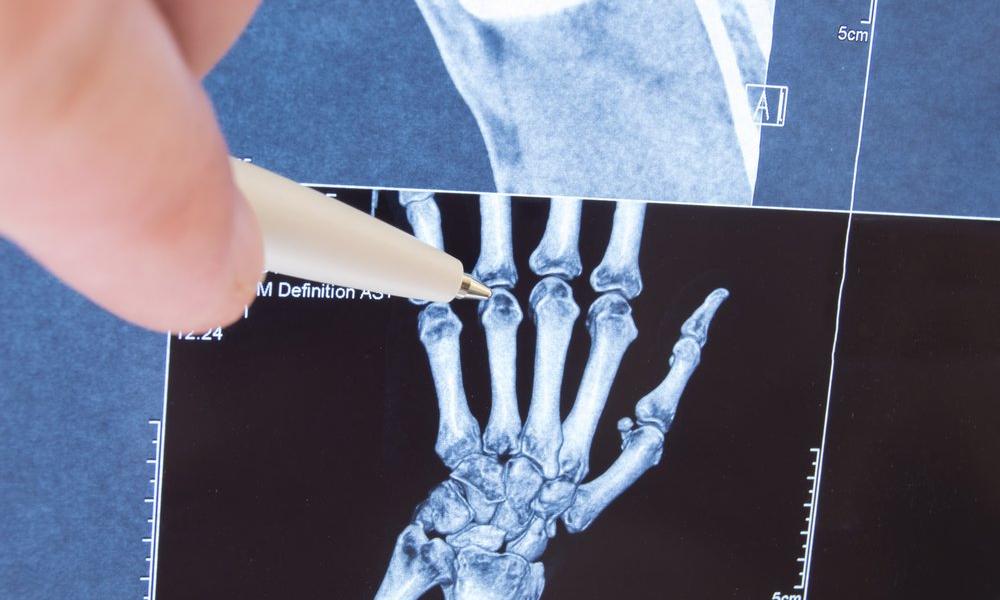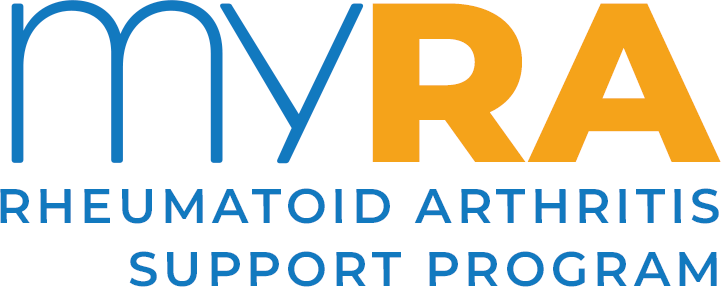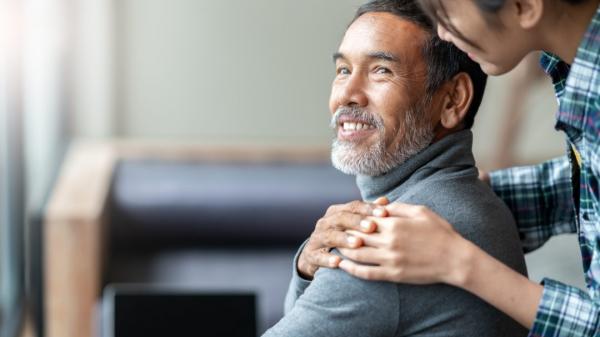
What is RA?
RA is a condition that can cause pain, swelling and stiffness in joints.
It is an auto-immune condition. This means that your immune system, which is your body’s natural self-defence system, gets confused and starts to attack your body’s healthy tissues. In RA, this results in inflammation in your joints and other parts of your body.
RA affects more than 400,000 adults in Australia. It can affect anyone of any age. It can get worse quickly, so early diagnosis and intensive treatment are important. The sooner you start treatment, the more effective it’s likely to be.
To understand how RA develops, it helps to understand how a normal joint works.
How does a normal joint work?
A joint is where two bones meet. Most of our joints are designed to allow the bones to move in certain directions and within certain limits.

For example, the knee is the largest joint in the body and one of the most complicated. It must be strong enough to take our weight and must lock into position, so we can stand upright.
It also has to act as a hinge, so we can walk, and needs to twist and turn when we run or play sports.
The end of each bone is covered with cartilage that has a very smooth, slippery surface. The cartilage allows the ends of the bones to move against each other, almost without rubbing.
The joint is held in place by the synovium, which contains thick fluid to protect the bones and joint.
The synovium has a tough outer layer that holds the joint in place and stops the bones moving too far.
Strong cords called tendons anchor the muscles to the bones.
What happens in a joint affected by RA?
If you have RA, your immune system can cause inflammation inside the joint(s). Inflammation is normally an important part of how your immune system works. It allows the body to send extra fluid and blood to a part of the body under attack from an infection. For example, if you have a cut that gets infected, the skin around it can become swollen and a different colour.
However, in the case of RA, this inflammation in the joint is unnecessary and causes problems.
When the inflammation settles, the capsule around the synovium remains stretched and can’t hold the joint in its proper position. This can cause the joint to become unstable and move into unusual positions.

Symptoms
The main symptoms of RA are:
- joint pain
- joint swelling, warmth and redness
- stiffness, especially first thing in the morning or after sitting still for a long time.
Other symptoms can include:
- tiredness and lack of energy – this can be known as fatigue
- a poor appetite (not feeling hungry)
- weight loss
- a high temperature, or a fever
- sweating
- dry eyes – as a result of inflammation
- chest pain – as a result of inflammation.
RA can affect any joint in your body, although it is often felt in the small joints in the hands and feet first. Both sides of the body are usually affected at the same time, in the same way, but this doesn’t always happen.
A few people develop fleshy lumps called rheumatoid nodules, which form under the skin around affected joints. They can sometimes be painful, but usually are not.
Causes
The following can play a part in why someone has rheumatoid arthritis:
Age
Rheumatoid arthritis affects adults of any age, although most people are diagnosed between the ages of 40 and 60.
Around three-quarters of people with rheumatoid arthritis are of working age when they are first diagnosed.
Sex
Rheumatoid arthritis is two to three times more common among women than men.
Genetics
Rheumatoid arthritis develops because of a combination of genetic and environmental factors, such as smoking and diet. It is unclear what the genetic link is, but it is thought that having a relative with the condition increases your chance of developing the condition.
Weight
If you are overweight, you have a significantly greater chance of developing rheumatoid arthritis than if you are a healthy weight.
The body mass index (BMI) is a measure that calculates if your weight is healthy, using your height and weight.
For most adults, an ideal BMI is in the 18.5 to 24.9 range.
If your BMI is:
- below 18.5 – you're in the underweight range
- between 18.5 and 24.9 – you're in the healthy weight range
- between 25 and 29.9 – you're in the overweight range
- between 30 and 39.9 – you're in the obese range.
To work out your BMI, use the healthy weight calculator.
Smoking
Cigarette smoking significantly increases the risk of developing rheumatoid arthritis. If you would like to stop smoking, visit the Quit Australia website.
Diet
There is some evidence that if you eat a lot of red meat and don’t consume much vitamin C, you may have an increased risk of developing rheumatoid arthritis.
How will rheumatoid arthritis affect me?
Because rheumatoid arthritis can affect different people in different ways, we can’t predict how the condition might develop for you.
If you smoke, it’s a very good idea to quit after a diagnosis of rheumatoid arthritis. This is because:
- rheumatoid arthritis may be worse in smokers than non-smokers
- smoking can weaken how well your medication works.
Physical activity is also important, as it can improve your symptoms and benefit your overall health.
Blood tests and x-rays will help your doctor assess how fast your arthritis is developing and what the outlook for the future may be. This will also help your doctor to decide which form of treatment to recommend.
The outlook for people with rheumatoid arthritis is improving all the time, as new and more effective treatments become available. It is possible to lead a full and active life with the condition, but it is important to take your medication, even when you are feeling well, as prescribed and make necessary lifestyle changes.
Diagnosis
A diagnosis of rheumatoid arthritis is based on your symptoms, a physical examination and the results of x-rays, scans and blood tests.
Because rheumatoid arthritis can affect other parts of the body, it’s important to tell your doctor about all the symptoms you’ve had, even if they don’t seem to be related.
Blood tests
Blood tests may be used to find changes in your blood that are produced by inflammation.
They can also show if you’re anaemic (have low levels of iron in your blood), as anaemia is common in people with rheumatoid arthritis.
X-rays and other tests
X-rays will show any damage caused to the joints by the inflammation that occurs in rheumatoid arthritis.
Doctors also use equipment such as ultrasound scans to look for inflammation and early damage to joints.
When your diagnosis has been confirmed, don’t be afraid to ask your doctor questions or talk about any problems the condition causes you. The more your healthcare team know about how arthritis is affecting you, the more they can help.
Treatment
There are a variety of treatments available for rheumatoid arthritis. The earlier that intensive treatment is started, the more likely it is to work.
There are three main ways to treat rheumatoid arthritis:
- drugs
- physical therapies
- surgery
Drugs
There are four main groups of drugs that are used to treat rheumatoid arthritis. These are:
- painkillers
- non-steroidal anti-inflammatory drugs (NSAIDs)
- disease-modifying anti-rheumatic drugs (DMARDs)
- steroids (also known as corticosteroids).
Many people with rheumatoid arthritis need to take more than one drug. This is because different drugs work in different ways.
Your drug treatments may be changed from time to time. This can depend on how bad your symptoms are, or because something relating to your condition has changed.
Medications may be available under several different names. Each medication has an approved name – sometimes called a generic name.
Manufacturers often give their own brand or trade name to the drug as well. For example, Nurofen is a brand name for ibuprofen.
The approved name should always be on the pharmacist’s label, even if a brand name appears on the packaging. Check with your doctor, rheumatology nurse specialist or pharmacist if you’re not sure about anything.
Painkillers
Painkillers (or analgesics) can help to relieve the pain caused by rheumatoid arthritis, but should not be the only treatment used.
There are many types and strengths of painkillers available – some can be bought over-the-counter from a pharmacy, while some are only available on prescription.
For guidance, ask a healthcare professional in charge of your care.
Disease-modifying anti-rheumatic drugs (DMARDs)
There are three types of DMARD:
- conventional synthetic DMARDs (sometimes called csDMARDs)
- biological therapies (sometimes called bDMARDs).
- targeted synthetic DMARDs (sometimes called tsDMARDS).
You will need to have regular blood tests if you take DMARDs, as they can affect your liver.
It may be a while before you notice your DMARD working – possibly a few months. It is important to keep taking your medication during this time.
The table below shows the DMARDs available for the treatment of rheumatoid arthritis.
| Name | Type of DMARD |
| Azathioprine | Conventional synthetic DMARD |
| Gold injections (Myocrisin) | Conventional synthetic DMARD |
| Hydroxychloroquine (Plaquenil) | Conventional synthetic DMARD |
| Leflunomide (Arava, Leflunomide medac, Leflunomide ratiopharm, Leflunomide Teva, Leflunomide Winthrop) | Conventional synthetic DMARD |
| Methotrexate (Nordimet) | Conventional synthetic DMARD |
| Sulfasalazine (Salazopyrin EN-Tabs) | Conventional synthetic DMARD |
| Etanercept (Enbrel, Benepali, Erelzi) | Biologic; Anti-TNF |
| Infliximab (Remicade, Remsima, Flixabi, Inflectra) | Biologic; Anti-TNF |
| Rituximab (MabThera, Truxima, Rixathon) | Biologic; Anti lymphocyte monoclonal antibody |
| Baricitinib (Olumiant) | Targeted synthetic DMARD |
| Tofacitinib (Xeljanz) | Targeted synthetic DMARD |
| Sarilumab | Biologic: Anti IL6 |
| Certolizumab pegol (Cimzia) | Biologic; Anti-TNF |
| Adalimumab (Amgevita, Cyltezo, Humira, Imraldi) | Biologic; Anti-TNF |
| Golimumab (Simponi) | Biologic; Anti-TNF |
| Abatacept (Orencia) | Biologic T cell co-stimulator |
| Tocilizumab (Actemra) | Biologic; Anti IL6 |
Steroids
Steroids are sometimes known by their full name: corticosteroids.
Corticosteroids help to reduce the pain, stiffness and inflammation caused by rheumatoid arthritis.
They can be used as:
- a tablet
- an injection directly into a painful joint
- an injection into your muscle.
They're usually used to provide short-term pain relief. This could be during a flare-up or while you're waiting for your DMARD medication to start working.
Corticosteroids are normally only used in this way because long-term use of corticosteroids can have serious side effects, including weight gain, osteoporosis and thinning of the skin.
You shouldn’t stop taking your steroid tablets or alter the dose unless advised to by your doctor. It can be dangerous to stop steroids suddenly.
Non-steroidal anti-inflammatory drugs (NSAIDs)
NSAIDs can be used to help control symptoms of pain, swelling or stiffness. They can be used in combination with painkillers.
NSAIDs start working within a few hours, with the effects felt for a few hours to a whole day.
Ibuprofen is a commonly prescribed NSAID.
NSAIDs can be taken as a:
- tablet
- capsule
- liquid
- suppository to be inserted into your bum
- cream
- gel.
Managing your symptoms
Managing a flare-up
When your symptoms get worse, this is known as a flare-up. These can happen at any time, but can happen after you have been stressed or had an infection.
Over time, you may get better at noticing the early signs of a flare-up.
If you’re having regular flare-ups, you should mention this to your doctor. It may be that you need to review your treatment.
Here are a few things you can do to help yourself during a flare-up:
- Keep taking your medication at the doses you’ve been prescribed.
- Do gentle exercises.
- Put heated items on the joint – these can include a hot water bottle or electric heat pad. See below for more information.
- Put cold items on the joint – these can include a bowl of cold water with ice cubes, a pack of frozen peas wrapped in a towel, or a damp towel that has been kept in the fridge. See below for more information.
- Let people around you know, so they can help and support you.
Tips for using heated items
Heated items that could help your joint pain include a hot water bottle or electric heat pad. Wrap these in a towel, then place on a painful joint. You could also try having a hot or warm shower or bath.
Other heated items that people have found useful are wheat bag, heat pads, deep heat cream, or a heat lamp.
Make sure these items are warm but not hot, as you could risk burning or scalding yourself. Gentle heat will be enough.
A towel should be placed between the heated item and the skin for protection. Check your skin regularly, to make sure it is not burning.
Tips for using ice packs
Some people find that using an ice pack can help their joint pain. You can buy one from a pharmacy, or you can make one at home, by wrapping ice cubes in a plastic bag or wet tea towel.
Here’s how to apply the ice to your skin:
- Rub a small amount of oil over where you’d like the ice pack to go. Any type of oil can be used. If your skin is broken – for example, if you have a cut – don’t use the oil and cover the area with a plastic bag. This will stop the cut getting wet.
- Put a cold, wet flannel over the oil.
- Put the ice pack over the flannel and hold it there.
- After five minutes, check the colour of your skin. Remove the ice pack if your skin has turned bright pink or red. If it hasn’t, leave it on for another 5 to 10 minutes.
- You can leave the ice pack on for 20-30 minutes. Don’t leave it on for any longer, as you could damage your skin if it is left on for too long.
Physical activity
Keeping physically active can improve your rheumatoid arthritis symptoms, including pain.
You may find it difficult to be physically active in the first place, especially if you are having a flare-up. However, if you find the right activities, help and support, you can be active in a way that suits you.
Not keeping active can lead to stiff joints and weak muscles. It could also cause you to gain weight.
If you are new to exercise, or haven’t exercised in some time, you may feel a bit sore the first few times you try a new activity. As you get used to it, this will get better.
However, if a type of exercise always causes a flare-up, it's probably best to find another one. High-impact exercises such as step exercises, or contact sports, such as rugby and football, are more likely to cause problems. Swimming, walking, gentle cycling and aqua aerobics generally put less strain on your joints.
Yoga and tai chi are generally thought to be suitable for those with rheumatoid arthritis. However, there are many different styles, so it is best to check the style is suitable for your condition before you sign up to a class.
You should also break up long periods of sitting with light activity, to avoid being sedentary for extended periods.
Physiotherapy
A physiotherapist can suggest suitable exercises for you and support you in keeping active.
People with rheumatoid arthritis should have access to specialist physiotherapy to help manage their condition and improve their fitness, flexibility and strength. You should also have follow-up reviews.
Find a physiotherapist on Australian Physiotherapy Association website.
Hydrotherapy
You may also find that hydrotherapy helps to ease your symptoms. This involves doing special exercises in a warm-water pool, under the supervision of a trained physiotherapist. Hydrotherapy can also be called ‘aquatic therapy’ or ‘aquatic physiotherapy’.
Your doctor should be able to refer you to physiotherapist if they think you might benefit from hydrotherapy. You can also refer yourself to a physiotherapist, who will assess whether hydrotherapy would be suitable for you.
Check before your treatment starts that you’re happy with the facility. A qualified physiotherapist will be registered with the Australian Health Practitioner Regulation Agency (AHPRA).
It can help to improve the pain in your joints, and you may also find it relaxing. Ask your doctor or physiotherapist if they think hydrotherapy would be suitable for you.
Foot problems
Foot problems for those with rheumatoid arthritis include:
- pain
- soreness
- warmth and swelling that lasts at least a few days
- the foot changing shape
- difficulty walking
- your shoes rubbing
- corns or calluses, and nail problems
- Infections such as athletes' foot, verruca or bacterial infections.
If these problems are left untreated, they can lead to the infections spreading and, eventually, to ulcers forming.
It is therefore important to see a podiatrist, who specialises in general foot care. They can give advice on footwear, information on how to treat foot problems yourself, and can provide special insoles. They can also monitor your foot and general health and will refer you to a consultant if they find any issues.
There may be a podiatrist in the rheumatology department where you receive your care, or you may get a referral to an NHS podiatrist. GPs can also refer you to community-based services.
Alternatively, you can access podiatry care privately.
You can find a private podiatrist on the Australian Podiatry Association website. All podiatrists should be registered with the Australian Health Practitioner Regulation Agency (AHPRA).
Complementary treatments
Complementary treatments can be useful when used alongside prescribed medicines for the treatment of rheumatoid arthritis. However, they should not replace your prescribed medicines and you should talk to your rheumatology team before starting a complementary treatment.
Generally complementary treatments aren't considered to be evidence-based and are therefore not usually available on the PBS.
Complementary medicines report
The table below shows a list of complementary medicines that have been tested in randomised controlled trials (RCTs). The trials looked at how effective each compound is for rheumatoid arthritis.
You can find out more about each compound and the results of the trials by following the links in the table, or download our complementary and alternative medicines report (PDF 1.4 MB).
| Compound | Effectiveness rating | Safety rating |
| Fish body oil | 5 | Green |
| Borage seed oil | 3 | Green |
| Evening primrose oil (EPO) | 3 | Green |
| Cat's claw | 2 | Amber |
| Rosehip | 2 | Green |
| Andrographis paniculata | 1 |
Green |
| Antler velvet | 1 | Green |
| Blackcurrant seed oil | 1 | Green |
| Collagen | 1 | Green |
| Feverfew | 1 | Green |
| Flaxseed oil | 1 | Amber |
| Green-lipped mussel | 1 | Green |
| Homeopathy | 1 | Green |
| Selenium | 1 | Green |
| Vitamins A, C and E | 1 | Green |
| Vitamin B complex | 1 | Green |
| Willow bark | 1 | Amber |
Living with rheumatoid arthritis
Occupational therapy
Occupational therapists can help you keep doing the activities you need or want to do – at home or at work. They will work with you to find different ways of doing things.
The benefits of seeing an occupational therapist include:
- improved confidence
- being able to do more things, at home or at work
- being able to live independently at home
- allowing you to return to or stay in work.
Ask your GP about occupational therapists that are local to you.
Be prepared to describe any difficulties you have and how they are affecting your life, or the lives of those who care for you.
You may want to know how long it will be until you get an appointment, so remember to ask if there is a waiting list.
You can also see an occupational therapist privately. You will be able to get an appointment quicker, but it will cost you money.
Find an occupational therapist on the Occupational Therapy Australia website. All occupational therapists should be registered with the Australian Health Practitioner Regulation Agency (AHPRA).
Aids and adaptations
If you have trouble doing everyday tasks, you may find it useful to use certain aids and adaptations.
Aids can help you manage everyday tasks such as bathing, dressing, and cooking. These can include shoehorns, rails or handles, and shower seats.
Adaptations are bigger items that can help you move around your home. These items include wheelchairs, fixed ramps and baths with built-in handles.
The National Disability Insurance Scheme (NDIS) aims to provide all Australians under the age of 65 years who have permanent or significant disability with the support they need to enjoy an normal life. For more information about how the NDIS can help you visit the website www.ndis.gov.au or call 1800 800 110.
Further support
If you are living with rheumatoid arthritis, you may also be living with one or more other conditions.
This is not unusual. Depression is the most common condition among people with rheumatoid arthritis, affecting one in six people.
If you are feeling low, talk to your GP or contact an organisation like beyond blue. beyondblue provides information and advice about depression, anxiety, available treatments and where to get help.
Surgery
Surgery is sometimes needed for those with rheumatoid arthritis. This can be to reduce pain, correct joint shape or restore your ability to use your joint. The types of surgery people with rheumatoid arthritis undergo are:
Foot Surgery
Examples of this type of surgery include:
- Removal of inflamed tissues around the joints of the forefoot.
- Removal of the small joints in the ball of the foot.
- Straightening of toes.
- Fixation of joints.
Finger, hand and wrist surgery
Examples of this type of surgery include:
- carpal tunnel release
- removal of inflamed tissue in the finger joints
- release of tendons in the fingers (this is used to treat unusual bending).
Arthroscopy
Arthroscopy is used to remove inflamed joint tissue.
During the operation, an arthroscope is inserted into the joint through a small cut in the skin, so the surgeon can see the affected joint. Damaged tissue is then removed. You usually don't have to stay overnight in hospital for this type of surgery, but the joint will need to be rested at home for several days.
Joint replacement
Some people with rheumatoid arthritis need surgery to replace part or all of a joint - this is known as a joint replacement, or arthroplasty. Common joint replacements include the hip, knee and shoulder.
Replacement of these joints is a major operation that involves several days in hospital, followed by rehabilitation, which can take months. The latest joints generally last for 10 to 20 years, and there is no guarantee that the new joint will be fully functional.
Sleep
Getting a good night’s sleep can be tough, especially when you are living with the aches, pains and inflammation of rheumatoid arthritis.
Sex and relationships
Most couples – whether they have arthritis or not – go through phases when their sex life is less exciting or satisfying than it was. There may be physical reasons for this, but emotional factors and stress often play a part.
Arthritis can present a number of challenges in a relationship, including the following:
- Pain and fatigue may reduce your enjoyment of sex, and other activities and interests that you share with your partner.
- Arthritis may mean that you can’t always manage the household jobs you usually do, or you may need help with them.
- If your arthritis affects your work, it may lead to financial worries.
- Having arthritis may affect your mood and self-esteem.
- Your partner will be concerned about how the condition is affecting you.
For more information, see our sex and arthritis content.











